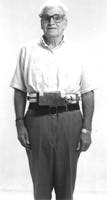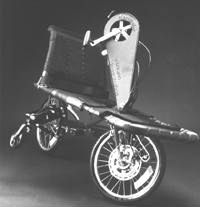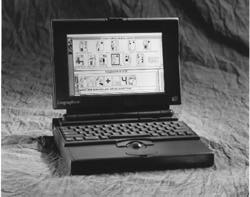1994 Project Reports | Contents | Previous | Next | Home |
Bringing products to market
Alvin H. Sacks, PhD; Maurice Le Blanc, MS; and David L. Jaffe, MS
Product Recruitment - The goal of the Product Recruitment program is to seek projects which have potential for satisfying worthwhile clinical ongoing projects in the Neuromuscular Systems, Orthopedic Biomechanics and Human Machine Integration sections of the Rehab R&D Center and also seeking projects with potential from clinical services in VAMC. Clinical needs assessments are conducted, "wish lists" are solicited, focus groups are held, and physicians and therapists are contacted for input into this process.
One example is the Accelerometry Balance project from the Human Machine Integration section. Falls due to impaired balance present a serious health hazard to elderly as well as to post-surgical and partially-disabled ambulatory persons. Balance, as well as hearing and vision, decline with age or injury. Each year one-third of the elderly living at home will fall. Approximately 1 in 40 of these persons will be hospitalized as a consequence of the fall. Impaired mobility due to balance deficits or a fear of falling can diminish a person's ability to perform activities of daily living, and often makes the difference between living independently at home or being supervised in a nursing home facility.
Investigators in the Human Machine Integration section are developing a small, wearable instrument that gathers balance information from the accelerations of a person's head and torso. The major objective is to provide real-time quantitative body motion analysis in the same environments and situations in which people actually fall. The purpose of the project is to study falls in the elderly and to help prevent them in the future. We think it has potential for effective use as a commercial product (Figure 1).
 Figure
1. The wearable balance sensing device.
Figure
1. The wearable balance sensing device.
Another example is the Tiltcycle project of the Neuromuscular Systems Section (see page 46). An objective evaluation and treatment tool for the rehabilitation of lower extremity movement deficits from strokes and other causes is greatly needed. Currently, lower extremity movement is assessed using either subjective visual methods or complicated and expensive motion analysis systems which few clinics can afford.
To benefit a wide range of patient populations and rehabilitation specialists, an improved evaluation and treatment tool is being developed by the Neuromuscular Systems Section. Current clinical and scientific literature have produced strong evidence suggesting that pedaling exercise can enhance strength, endurance, and movement in various rehabilitation patient populations (i.e. cardiac, orthopaedic, and neurological). In addition, recent data suggests that movement capability should be assessed and treated under differing conditions, such as changing body orientation, and coupled vs uncoupled mechanical conditions. This more complete rehabilitation approach enables a patient to practice movement under diverse environmental conditions as exist in the real world. The Tiltcycle is applicable to a wide range of patient populations. Ambulatory patients, and more importantly non-ambulatory or pre-ambulatory patients, will benefit from exercising on this device. Potential rehabilitation populations to benefit include, but are not restricted to, stroke, head injury, multiple sclerosis, post-polio, amputees, orthopaedic surgery, arthritis and heart disease patients. Further work will include correlating pedaling performance with functional deficits that commonly occur with brain injury. We think that the Tiltcycle has promise as a commercial product for the rehab clinic.
Product Evaluation - The goal of the Product Evaluation program is to screen projects for commercial potential and to perform formal clinical evaluation. In the first phase of this process, assessment screening, the results from the product recruitment phase are analyzed to assess and prioritize the market potential of Center projects involving a device, a technology, or a technique. Center funds and personnel are allocated to projects which have the highest market potential. These resources can be employed to construct an advanced prototype or refine a promising technique.
Next, in the design/development and clinical evaluation phase, the prototype or technique is evaluated locally with clients. Such small studies provide valuable information on the project's effectiveness with real users. Alternatively, the VA's Technology Transfer Service in Baltimore can be contacted for the construction of commercial prototypes for evaluation nationally at several VA sites. [Note: The VA Technology Transfer Program (TTP) no longer evaluates commercial prototypes. DJ - 08/23/2006]
A successful evaluation is necessary before the device can be placed on the VA's list of reimbursable products. This process has been used to evaluate three Center projects: the Ultrasonic head controlled wheelchair, the HandBike (Figure 2), and the Desktop robotic aid.
 Figure
2. The HandBike developed at the Rehab R&D Center.
Figure
2. The HandBike developed at the Rehab R&D Center.
Support for design/development and clinical evaluation can also be provided through a Cooperative Research and Development agreement by a federal agency under programs such as the Small Business Innovative Research (SBIR). In these cases a small commercial company is involved and is encouraged to develop a viable commercial product.
A contract between Gallaudet University (funded by the National Institute of Disability and Rehabilitation Research) and the Palo Alto Institute for Research and Education (a non-profit organization associated with the Palo Alto VA Medical Center) resulted in the construction (by the Rehab R&D Center) and evaluation (by Gallaudet and AI duPont Institute) of two mechanical fingerspelling hands. SBIR funding is now being sought to produce and evaluate a commercial version of this device.
Finally, a package of information is prepared on each project. This documentation includes data sheets and photographs as well as any marketing information. The package is provided to interested manufacturers or technology transfer partners.
Product Availability - The goal of the Product Availability program is to carry out a negotiated collaboration with a private company to develop and market a successful commercial product based on promising products of the Center. This is accomplished by seeking appropriate manufacturers for each product, entering into discussion about manufacturability and market size with those companies interested, selecting a company with whom to pursue each product, preparing necessary legal arrangements, and assisting companies with the transfer and possibly with education and training as well.
One example of a successful collaboration is Lingraphica (Figure 3), an assistive and therapeutic communication device for persons with aphasia from stroke or other brain injury . A research scientist and linguist Richard Steele from the Center met with a team of investigators from the Boston Aphasia Research Center to discuss VIC, a low-tech visual communication system for people with global aphasia. The team presented a method of communication which used decks of cards with pictures or symbols that could be manipulated by the patient to produce meaningful, if elementary, communication.
 Figure
3. Lingraphica, manufactured by Tolfa Corporation.
Figure
3. Lingraphica, manufactured by Tolfa Corporation.
It was evident to Steele and the other researchers that the method was both cumbersome and limited and could be vastly improved and expanded by intelligent use of the emerging personal computer technology that employed high-resolution graphic displays. He began formulating a project to develop a computerized visual communication system for aphasics, dubbed C-VIC, which would require only moving the mouse with one hand. With the concentrated involvement of Michael Weinrich, MD, then Chief of Neurology at the Palo Alto VA Medical Center, as well as speech therapists and a programmer, Steele's team proceeded, with VA funding, to develop, refine and test the system on aphasic patients at several medical centers.
The C-VIC system demonstrated its functional value, and the inventors filed a Disclosure of Invention with the General Counsel for their agency, the Department of Veterans Affairs (VA) in Washington, DC, as required of all federal employees involved in technology development. In consideration of the circumstances and the interests of the VA, General Counsel informed the researchers that the US Government was turning over all patent rights to them, with the usual condition that the Government retain a royalty-free, paid-up license to make and use the invention for government purposes.
A license was negotiated between the inventors and an entrepreneurial group for further development and commercialization of the C-VIC technology. The following year, this group formed a start-up company, Tolfa, to develop and market it as a commercial product. In just under one year, the commercial product Lingraphica appeared on the market. A patent application was filed, and a patent was issued. The VA formally approved the device for inclusion in its list of reimbursable prosthetic appliances for eligible veterans. Both the Rehab R&D Center and Tolfa jointly received a National Award of Excellence in Technology Transfer from the Technology Utilization Foundation in December 1993 for their work in developing and commercializing Lingraphica.
Products of R&D in the Center which have been made commercially available:
| Product | Manufacturer |
| Lingraphicia | Tolfa Corporation, Oakland, CA |
| Handbike | New Dimensions Design, Elmira, OH |
| Software for Interactive Musculosketal Modeling (SIMM) | Musculographics, Evanston, IL |
| Low Vision Reference | The Lighthouse, New York, NY |
| Computer EMG Analysis | Nicolet, Madison, WI |
| VA Seat Interface Orthosis (VASIO) | Tumble Forms, Dolgeville, NY |
| Arroyo Sitski | Beneficial Designs, Santa Cruz, CA |
| Alexis | Intex Corporation, San Antonio, TX |
| Nerve Conduction Analysis | Nicolet, Madison, WI |
| Twist | Orthopedic Biomechanics Section |
Republished from the 1994 Rehabilitation R&D Center Progress Report.